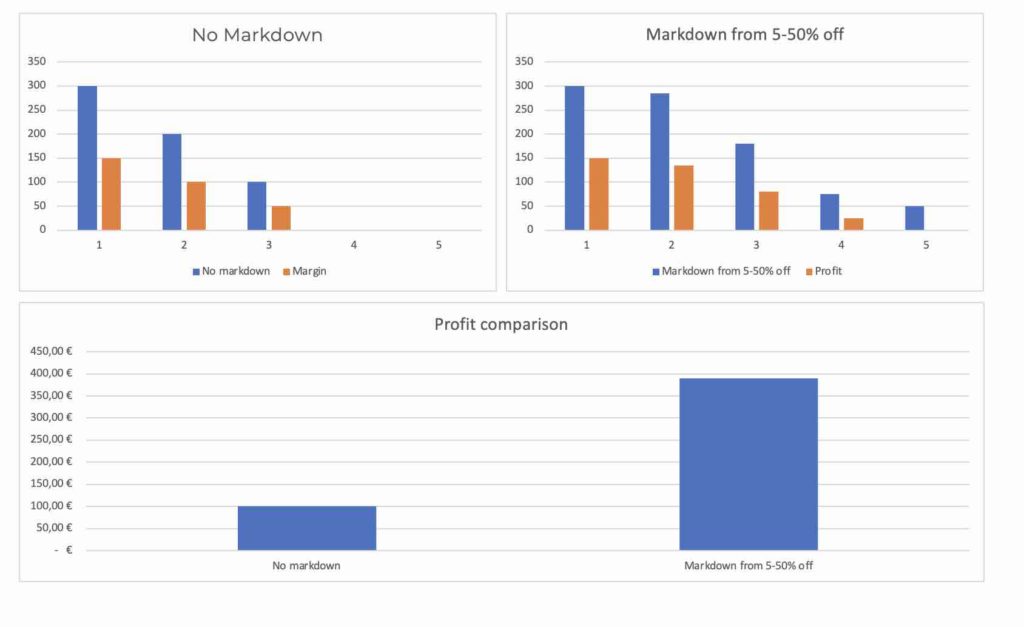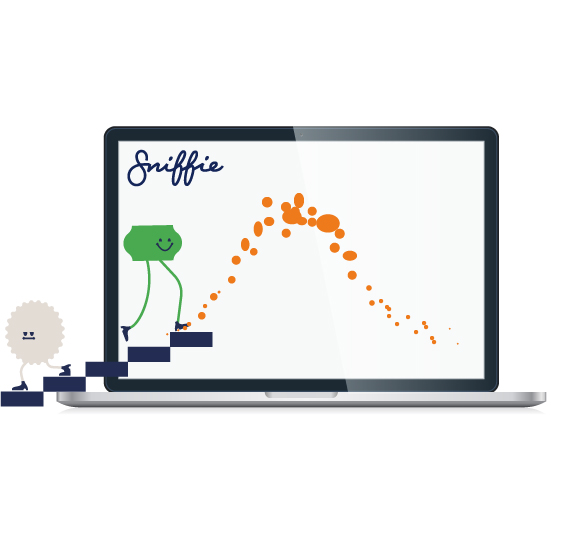Maintaining a good level of inventory has been a significant struggle for retailers. If the supply is lower than the demand, it might lead to loss in sales. But when the stock levels high compared to the demand, it reduces shelf space and decreases the cash flow. This situation presents an opportunity for markdown pricing!
One way to push the sales is to do a markdown in pricing. A markdown strategy is essential and should be planned as part of the product lifecycle strategy because it can drain more profits than necessary. However, when planned correctly, it can minimize inventory and maximize profits.
Let’s discuss the definition of ‘markdown’ first…
What does markdown mean in pricing?
Markdown pricing is a pricing strategy used by retailers to reduce the price of a product to increase sales and clear out inventory. It is especially important in keeping seasonal products profitable and avoid unnecessary waste and loss.
Use markdown pricing for products that are not selling well or are approaching the end of their seasonal lifetime. In some cases, companies can use markdown pricing to attract new customers by offering discounts on certain products.
The goal of markdown pricing is to increase sales and revenue while also reducing the amount of unsold inventory. You can implement markdown pricing through various methods, such as temporary price reductions, clearance sales, and promotional discounts. This pricing strategy is helpful for a wide range of products, from clothing and accessories to electronics and home goods. However, retailers should carefully analyze consumer demand and trends, inventory levels and sales data to make the most of markdown pricing.
There are four main reasons to use markdown pricing in retail and e-commerce:
- Clear inventory to create space for new products.
- Push stock excess of seasonal products before the season’s end.
- Speed up sales before the expiration dates of products.
- Increase sales of slow-moving products.
Markdown Case Example

FAM Brands needed an automated tool for end-of-season apparel markdown. So the team chose Sniffie Markdown and Profit Optimization AI for their markdown automation.
Results
10% increase in profit and 40% higher sales volumes.
What is the difference between markdown pricing and a discount campaign?
Although, markdown can create a similar effect of increased sales as a discount campaign, the purpose and approach of these strategies are different.
Both markdown and discount result in a price reduction, but for different reasons. A markdown campaign uses price reduction for selling all products out, and a discount campaign is only generating higher sales volumes for a shorter period of times. In short, a markdown reflects market value, whereas a discount is not. If you are looking to optimize discount campaign pricing you might want to take a spin of our discount campaign pricing simulator.
The profitability problem the markdown pricing is solving
As a retailer or Ecommerce company, you know that every sale counts when it comes to your bottom line. But what happens when you have products that just aren’t moving? That’s where markdown pricing comes in. With this strategy, you can reduce the prices of select items to increase sales and clear out excess inventory.
Let’s say you have ten products, each with a cost of goods sold (COGS) of 50€ and a retail price of 100€. Of course, you would need to sell at least 5 at full price to break even. But imagine being able to sell all 10 of them at a reduced price rather than being stuck with unsold inventory. Not only would you reach your break-even point, but you would also increase your profits with every single sold item.

Optimizing your end-of-season sales with markdown pricing ensures you are not left with unsold inventory that eats into your profits. It’s a win-win: sell all of your products, and you’re hitting your targets, but deal only some, and your margin targets need to catch up. So don’t leave money on the table; make markdown pricing a part of your sales strategy.
How to build a markdown pricing strategy basis to your organization?
Markdown has a single purpose – to clear out your remaining inventory by the end of the product life cycle or season while maximizing gross margins and minimizing waste. Therefore, the price markdown is usually a permanent change in the selling price, which with modern AI technologies, can be made dynamic based on demand. Therefore, if an item sells higher than expected after starting the markdown, the pricing engine changes the price to a more profitable price point. But before we go into practicalities, you should understand how to build a markdown pricing plan and set the right goals.
A markdown pricing strategy should entail a plan that describes when and how a markdown is applied to a specific product or category. This strategy should be part of and taken into consideration in the product life cycle, seasonality and company targets like cash and capital employed.
Yet, it is almost impossible to manually identify all overstock products throughout a large assortment early enough to take proactive actions. Even more, calculating the best price markdown that generates the most optimum margin. But a clear strategy and monitoring process will help you achieve the best possible outcome.
To build a markdown pricing strategy you need a data to understand when and how to start the markdown campaign. Sure, later on you will notice that you need to automate most of the tasks that you are doing, but undertanding the premises of your strategy will simplify your approach.
Firstly, set clear guidelines on how and when to start markdown campaign. Secondly, employ demand forecasts to pinpoint the potential overstock conditions and seasonal demand decreases. Monitoring those is your key vitals in seasonal businesses. Thirdly, plan how long or fast is your markdown campaigns. Understanding your demand will help you set optimum pricing to clear that excess stock quickly or in time while maximizing the margin. Finally, ensure your strategy includes how to communicate, monitor and analyze the results of your markdown campaigns.
Retailers and Ecommerce companies can be easily divided into two categories based on their strategic capability. Reactive retailers notice the issue when the overstocking is already too evident by the time it is identified. Proactive retailers analyze with the above approach their demand and know when to start markdown in perfect time.
How to build a strong and effective markdown pricing strategy?
Checklist for creating markdown pricing campaign
Markdown pricing campaigns can be an effective way for fashion brands to increase sales, clear out inventory, and attract new customers. However, preparing for these campaigns to achieve the desired results is essential. Here is a 10-step checklist for fashion, seasonal and best before dated brands to follow when preparing for a markdown pricing campaign:
- Identify the products that need the markdown pricing campaign. These should be products that could be selling better, have been in the collection for too long, or are approaching the end of their seasonal lifetime.
- Understand the seasonal lifetime of the products by using the previous season’s data on similar or the same products. This data will help determine the right time to launch the markdown campaign.
- Analyze the thresholds at which stage the markdown campaign should be set on. It is essential to set the right thresholds so the campaign isn’t launched too soon or too late.
- Set clear goals for the markdown campaign, such as increasing sales volumes, clearing out inventory by a specific date, or attracting new customers with the price. These goals will help guide the campaign and measure its success.
- Calculate the best price points based on price elasticity (get a free price elasticity calculator from here) and demand information you have on those products. This will help ensure that the markdown prices are attractive to customers and allow the brand to make a profit.
- Determine the markdown percentages and sale prices for each product or use AI-driven software to optimize the prices. Markdown percentages ensure that the markdown prices are attractive to customers and allow the brand to make a profit.
- Create a schedule for the markdown campaign, including the start and end dates. It is imperative to set the final sellout date so the campaign stays manageable and maintains its effectiveness.
- Communicate the markdown pricing campaign to customers through various channels, such as email, social media, and in-store signage, with clear descriptions of the campaign. This will help attract customers and create excitement around the campaign.
- Prepare inventory management systems to ensure that products are correctly tracked, sold out, or in some cases, replenished as needed. This will help ensure that the campaign runs smoothly and that products are available to customers during the campaign.
- Coordinate with all store managers and sales associates to ensure they know the markdown campaign and can effectively communicate the discounts to their customers. Doing so will help all parties be aware of the campaign and can take advantage of the discounts.
- Consider using additional incentives, such as free shipping or a gift with purchase, to give customers further reasons to purchase the markdown campaign.
- Monitor the progress of the campaign and make adjustments as needed. Monitoring will sharpen your approach for the markdown campaigns and help you to achieve the goals you set out to achieve.
- Evaluate the campaign’s success and use the data to inform future markdown pricing strategies.
In conclusion, a markdown pricing campaign can be a valuable tool for seasonal brands to increase sales, clear out inventory, and attract new customers. By following the above steps outlined in this checklist, brands can ensure that their markdown pricing campaign is well-prepared and effective. In addition, using AI-driven software like Sniffie, brands can optimize prices, thus achieving better results and reaching their goals.
Get the Strategic Pricing Gateway Calculator
With our Strategic Pricing Gateway Calculator you will be able to easily calculate the demand for your products with clear visual graphs. Totally free!
If you don’t see the form below, try disabling ad blockers on your browser.



